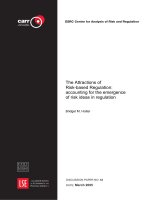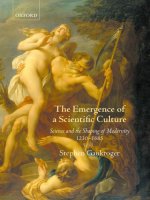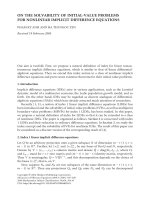The Emergence of Biological Value
Bạn đang xem bản rút gọn của tài liệu. Xem và tải ngay bản đầy đủ của tài liệu tại đây (90.17 KB, 17 trang )
P1: JZZ
0521829496c11.xml CY335B/Dembski 0 521 82949 6 March 10, 2004 1:32
11
The Emergence of Biological Value
James Barham
1.
introduction
All the things we think of as paradigmatic cases of design – novels, paint-
ings, symphonies, clothes, houses, automobiles, computers – are the work
of human hands guided by human minds. Thus, design might be defined
as matter arranged by a mind for a purpose that it values. But this raises the
question, what are minds? Presumably, the activity of brains. The problem
with this answer, however, is that brains themselves give every appearance
of being designed. Most contemporary thinkers view brains as neurons ar-
ranged for the purpose of thinking in much the same way that, say, mouse-
traps are springs and levers arranged for the purpose of killing mice. But
if that is so, then who arranged the neurons? Who or what values thinking,
and whose purpose does it serve?
It is generally supposed that there are only two ways to answer these
questions. One way has come to be known as Intelligent Design. On this view,
our brains were designed by other minds existing elsewhere – say, in another
galaxy or on another plane of being. But if these other minds are also
instantiated in matter, then we have the same problem all over again. If not,
then we have an even more difficult problem than the one we started with.
To invoke immaterial minds to explain the design of material ones is surely
a case of obscurum per obscurius.
The other way is what I shall call the Mechanistic Consensus. In summary,
the Mechanistic Consensus holds that (1) the known laws of physics and
chemistry, together with special disciplines such as molecular biology, fully
explain how living things work, and (2) the theory of natural selection ex-
plains how these laws have come to cooperate with one another to produce
the appearance of design in organisms. According to the Mechanistic Con-
sensus, design is not objectively real but merely an optical illusion, like the
rising and setting of the sun. On this view, living matter is nothing special.
It is just chemistry shaped by natural selection.
210
P1: JZZ
0521829496c11.xml CY335B/Dembski 0 521 82949 6 March 10, 2004 1:32
The Emergence of Biological Value
211
In this paper, I will argue that the Mechanistic Consensus is wrong. It is
wrong because, conventional wisdom to the contrary, (1) present day physics
and chemistry do not provide the conceptual resources for a complete un-
derstanding of how living things work, and (2) natural selection does not
provide an adequate means of naturalizing the normative teleology in living
things. However, in spite of this failure of the Mechanistic Consensus, I will
argue that we are still not forced to the Intelligent Design position, because
there exists a third way of explaining the appearance of design in living
things.
One of the hallmarks of a machine is that the relationship between its
function and its material constitution is arbitrary. Intelligent Design and
the Mechanistic Consensus agree that organisms are machines in this sense,
consisting of matter that is inert insofar as its function is concerned. Both
schools of thought view biological functions as something imposed on in-
ert matter from the outside, by the hand of God or by natural selection, as
the case may be. But what if the analogy between organisms and machines
were fundamentally flawed? Suppose that the teleological and normative
character of living things really derived from an essential connection be-
tween biological function and the spontaneous activity of living matter. In
that case, such a connection might give rise to systems that prefer or value
some of their own possible states over other, energetically equivalent ones,
and that strive to attain these preferred states under the constraint of ex-
ternal conditions in accordance with means-ends logic. Then, instead of
being an illusion, as the Mechanistic Consensus claims, the purpose and
value seemingly inherent in the functional actions of living things might be
objectively real. If all of this were so – and I will argue that it is – then living
matter would be special, after all. Although we have little idea as yet in what
this specialness consists, in the last section of this chapter I will briefly con-
sider the implications of some promising lines of contemporary research in
nonlinear dynamics and condensed matter physics for understanding the
emergence of biological value.
2.
the mechanist’s dilemma
Living things give every appearance of purposiveness. It is entirely natural to
describe biological processes as functions that operate according to means-
ends logic. Functional ends or goals constitute norms with respect to which
the means chosen may be judged good or bad, right or wrong, successful or
unsuccessful. Furthermore, organisms must be capable of choosing means
appropriate to their ends – that is, of being right – at least some of the time.
For example, in order to live, a cell must move in the right direction when it
encounters a nutrient gradient. The very existence of life presupposes the
possibility of correct functioning. On the other hand, organisms are also
necessarily capable of error. What appears to be a nutrient gradient may in
P1: JZZ
0521829496c11.xml CY335B/Dembski 0 521 82949 6 March 10, 2004 1:32
212
James Barham
fact turn out to be a lure or a poison. Functions are inherently capable of
malfunctioning. Right or wrong, organisms behave according to functional
logic. This is done so that that may happen. A is preferred; B is necessary for
A; therefore, B is chosen. All function conforms to this pattern. Which is
to say that, in pursuing their ends, organisms are not propelled by causes;
rather, they act for reasons.
Behavior answering to these ordinary-language descriptions clearly ex-
ists. It is easily confirmed through elementary empirical observation. True,
the teleological and normative language used in the previous paragraph
to describe functional behavior might be dismissed as pretheoretical and
without scientific value. But this claim presupposes the existence of an alter-
native theoretical language into which these descriptions can be translated
without loss. This language must itself be rigorously purged of all traces of
teleology and normativity. Does such a language in fact exist?
Open any cell biology textbook to any page, and what will you find?
Talk of regulation, control, signals, receptors, messengers, codes, transcrip-
tion, translation, editing, proofreading, and many other, similar terms. It
is true that this technical vocabulary is an indispensable aid in describing
many previously undreamed-of empirical phenomena. Molecular biology
has greatly extended the scope and precision of our knowledge, and the
terminology it has developed is an integral part of that accomplishment.
But the fact remains that these concepts are no less normative than those of
everyday speech. Adherents of the Mechanistic Consensus are untroubled
by this defect, because they insist that it is only a matter of convenience. A
metaphor like “second messenger,” they say, is employed only to avoid in-
tolerably verbose descriptions of the mechanistic interactions that underlie
the appearances. Such a fac¸on de parler is a promissory note redeemable in
the hard currency of physics and chemistry. But as with any IOU, the notes
issued by molecular biology are only as good as the guarantors backing
them up. If the other sciences cannot pay them either, then the promises
are worthless. For this reason, it behooves us to take a closer look at the
conceptual solvency of the Mechanistic Consensus.
First, we are told that living things are made of ordinary matter and
nothing but ordinary matter. And it is true that biological molecules are
composed mostly of a handful of elements (CHNOPS), along with traces
of some others, all long familiar to chemists. Certainly, there are no un-
known elements in living things that are not present in the periodic table.
Second, we are assured that the interactions between these elements in vivo
are basically the same as those in vitro described by present day physics
and chemistry. This is a more doubtful claim, to which I shall return later,
but for now, let us grant this, too. Even so, there remains a fundamental
difficulty.
The difficulty is that, while all the individual reactions in the cell may be
described in ordinary physical terms as tending toward an energy minimum,
P1: JZZ
0521829496c11.xml CY335B/Dembski 0 521 82949 6 March 10, 2004 1:32
The Emergence of Biological Value
213
the same cannot be said of the way in which the reactions are orga-
nized. When a signal molecule (say, a hormone) interacts with its receptor
(a protein), what happens may be more or less understood in terms of
biochemistry. But biochemistry has no conceptual resources with which to
explain the meaning and the purpose of this reaction – the very things that
constitute the reaction as a signal, and not just a meaningless jostling of
matter. What makes the living cell profoundly different from ordinary inor-
ganic matter is the way in which each reaction is coordinated with all the
others for the good of the whole. There is no doubt that this coordination
itself transcends the explanatory resources of biochemistry, because it oper-
ates according to functional logic, not just according to physical law (Pattee
1982; Rosen 1991; Jonker et al. 2002).
From a purely physical point of view – at least so far as our present state
of knowledge is concerned – there is no reason why a reaction that is good
for the organism, rather than one that is bad for it, should occur. The
very categories of good and bad have no place in physics or chemistry as
currently understood, and yet they are at the very heart of life. Every reaction
in the cell is more than just a reaction, it is a functional action. Such an
action constitutes a choice among states that are energetically equivalent
so far as the ordinary laws of physics are concerned. Such preferred states
are achieved, not by minimizing energy, but by doing work – that is, by
directing internally stored energy here or there according to needs that are
normative for the cell. Just as the laws of physics permit me to direct my
automobile left or right at an intersection, so too they permit a cell to travel
up or down a chemical gradient. There is no use seeking the explanation
for such decisions in the physical forces impinging on me or on the cell. It
is not physics (at least, not any presently understood physics) that explains
purposive action; rather, it is the situational logic of functional action that
governs the decisions of cells as integrated wholes (Albrecht-Buehler, 1990;
Alt, 1994; Lauffenburger and Horwitz, 1996).
During the past fifty years or so, we have developed a highly sophisticated
theoretical framework to explain how such coordinated, goal-directed ac-
tion works – namely, the theory of feedback and cybernetic control. This
theoretical understanding has made possible the construction of complex,
self-regulating mechanical systems that operate according to a functional
logic similar to that in living things and that fulfill a wide variety of human
purposes. There is no doubt that this body of theory provides a great deal
of insight into the internal operation of biological systems as well. But there
remains a glaring problem. In the case of the machine, we decide what
counts as its goal states, and we arrange its parts accordingly. Who or what
does these things in the cell?
It is often assumed that invoking the concept of information will somehow
solve this problem. It is true that all living things utilize information in
some sense (Loewenstein 1999). However, this observation merely labels the
P1: JZZ
0521829496c11.xml CY335B/Dembski 0 521 82949 6 March 10, 2004 1:32
214
James Barham
problem; it contributes little or nothing to its solution. The reason is that,
by definition, information is essentially semantic. Without meaning, there is
no information; there are just spatial or temporal patterns. For a pattern to
constitute information, we must posit a cognitive agent for which the pattern
is meaningful. What, then, is semantic information? One plausible answer
is: a correlation between events and functional actions without tight thermodynamic
coupling.
The proviso is important, because correlations that are the direct result
of the laws of physics do not constitute information. Information is only pos-
sible where choice exists. For choice to exist, the causes of the correlated
events must be orthogonal to each other (Nagel 1998). Causes are said to
be orthogonal if they are independent of each other insofar as the laws of
physics are concerned – that is, if the existence of one does not necessitate
the existence of the other. This is indeed the case throughout the living
cell (Monod 1972; Pattee 2001; Polanyi 1969). In short, if the correlation
between events in the cell were the direct result of the minimization of en-
ergy due to tight thermodynamic coupling, then it would make no sense
to speak of their occurring on the basis of information. Since that is not
the case, it does make sense to speak in this way. Without tight thermo-
dynamic coupling, an event may act as a trigger of a functional action. In
that case, the meaning of such an event may be interpreted as a sign of the
presence of conditions favorable to the action. In effect, information is an
event that tells a biological function: act now, and you will succeed (Barham
1996). Note, however, that the question of how such a correlation between
events and goal-directed actions is possible is essentially the same problem
that we have been discussing all along – that of explaining the design or
normative teleology inherent in life. Shannonian information theory is of
no help at all in solving this problem. It simply assumes intelligent agents
at either end of the communication channel; it makes no pretense of ex-
plaining how physical patterns can acquire meaning in the first place. For
this reason, in its present theoretical articulation, the concept of informa-
tion is an integral part of the problem. It contributes little or nothing to its
solution.
If the functional logic of the cell is irreducible to physical law as we cur-
rently understand it, then there would appear to be only two ways to explain
it naturalistically. Either the teleological design of living things is, at bottom,
a matter of chance; or else there is some unknown qualitative difference in-
herent in the material constitution of organisms that gives them an intrinsic
functional integrity. The first option is appealing to the mechanistic biolo-
gist, but it is very hard for the physicist to swallow because of the fantastic
improbability of living things from a statistical-mechanical point of view, as
has often been pointed out (Eden 1967; Elsasser 1998; Lecomte du No¨uy
1948; Schoffeniels 1976; Yockey 1992). The second option has attracted a
number of physicists who have thought seriously about life (Denbigh 1975;
P1: JZZ
0521829496c11.xml CY335B/Dembski 0 521 82949 6 March 10, 2004 1:32
The Emergence of Biological Value
215
Elsasser 1998; Schr¨odinger 1992), but it is unpalatable to most biologists
because to them it smacks of prescientific “vitalism.”
This, then, is the Mechanist’s Dilemma. Is life a statistical miracle? Or
is the Mechanistic Consensus defective in some fundamental way? I will
examine the first horn of this dilemma in the next section and the other
one in section 4.
3.
normativity and natural selection
According to the Mechanistic Consensus, the things that happen in organ-
isms do not really happen for a purpose; it only looks that way. In reality,
things just happen. Period. What happens in the organism is no different
from what happens in the test tube. Enzymes cleave or bond their substrates
according to the well-known laws of physics and chemistry. A catalyst is a
catalyst is a catalyst. How, then, do mechanists explain the appearance of
purposiveness in living things?
They say that some of the things that happen by chance in an organism
have the consequence that they enhance the organism’s fitness. This means
that the probability of the organism’s surviving to reproduce within a given
set of environmental conditions is increased by the physical or chemical
event in question. When this happens, the propensity for that event to oc-
cur will be transmitted to the next generation. Then, this event will tend
to recur and to have the same consequence in the offspring, so long as
the same environmental conditions exist, and likewise in the offspring’s off-
spring. In this way, the representation of the original event in the overall
population will gradually increase. At the limit, an event that first occurred
in a single organism will spread to all members of a species. In that case, it
will appear as though these organisms had been designed for their environ-
ment with respect to the event in question. But in reality, all that has hap-
pened is that the process of natural selection has locked into place an event
that originally occurred by chance insofar as its fit with the environment is
concerned.
It is widely assumed that this explanatory scheme gets rid of all the trou-
blesome teleology in biology, but this is a mistake. Natural selection pro-
vides only the appearance of reduction, not the reality, as may be seen from
a number of considerations. To begin with, we may note that the notions
of survival and reproduction undergird the entire Darwinian schema and
are not themselves explained by it. But these concepts already remove us
from the terra firma of physical interactions and land us right back in the
teleological soup. It is sometimes claimed that the stability of a chemical
compound constitutes “survival” or that crystal growth is a primitive form
of “reproduction,” but these metaphors merely obscure the point at issue.
Chemical compounds and crystals just seek their energy minimum given a
set of contraints, whereas the intelligent responsiveness of an organism to









